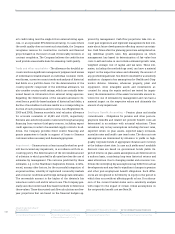Siemens 2009 Annual Report Download - page 226
Download and view the complete annual report
Please find page 226 of the 2009 Siemens annual report below. You can navigate through the pages in the report by either clicking on the pages listed below, or by using the keyword search tool below to find specific information within the annual report.
Reports Supervisory Board /
Managing Board Corporate Governance Management’s discussion and analysis Consolidated Financial Statements
Consolidated Statements of Income Consolidated Statements of Income
and Expense Recognized in Equity
Consolidated Balance Sheets Consolidated Statements of Cash Flow
proved by management. Cash flow projections take into ac-
count past experience and represent management’s best esti-
mate about future developments reflecting current uncertain-
ties. Cash flows after the planning period are extrapolated us-
ing individual growth rates. Key assumptions on which
management has based its determination of fair value less
costs to sell and value in use include estimated growth rates,
weighted average cost of capital and tax rates. These esti-
mates, including the methodology used, can have a material
impact on the respective values and ultimately the amount of
any goodwill impairment. See Note 16 Goodwill for a sensitivity
analysis on changes in key assumptions for Healthcare’s Diag-
nostics division. Likewise, whenever property, plant and
equipment, other intangible assets and investments ac-
counted for using the equity method are tested for impair-
ment, the determination of the assets’ recoverable amount in-
volves the use of estimates by management and can have a
material impact on the respective values and ultimately the
amount of any impairment.
Employee Benefit Accounting – Pension plans and similar
commitments – Obligations for pension and other post-em-
ployment benefits and related net periodic benefit costs are
determined in accordance with actuarial valuations. These
valuations rely on key assumptions including discount rates,
expected return on plan assets, expected salary increases,
mortality rates and health care trend rates. The discount rate
assumptions are determined by reference to yields on high-
quality corporate bonds of appropriate duration and currency
at the balance sheet date. In case such yields aren’t available
discount rates are based on government bonds yields. Ex-
pected returns on plan assets assumptions are determined on
a uniform basis, considering long-term historical returns and
asset allocations. Due to changing market and economic con-
ditions the underlying key assumptions may differ from actual
developments and may lead to significant changes in pension
and other post-employment benefit obligations. Such differ-
ences are recognized in full directly in equity in the period in
which they occur without affecting profit or loss. For a discus-
sion of the current funded status and a sensitivity analysis
with respect to the impact of certain critical assumptions on
the net periodic benefit cost see Note 24.
er’s credit rating must be single B from external rating agen-
cies, or an equivalent SFS-determined rating. In cases where
the credit quality does not meet such standards, the Company
recognizes revenue for construction contracts and financed
projects based on the lower of cash if irrevocably received, or
contract completion. The Company believes the credit factors
used provide a reasonable basis for assessing credit quality.
Trade and other receivables – The allowance for doubtful ac-
counts involves significant management judgment and review
of individual receivables based on individual customer credit-
worthiness, current economic trends and analysis of historical
bad debts on a portfolio basis. For the determination of the
country-specific component of the individual allowance, we
also consider country credit ratings, which are centrally deter-
mined based on information from external rating agencies.
Regarding the determination of the valuation allowance de-
rived from a portfolio-based analysis of historical bad debts, a
decline of receivables in volume results in a corresponding re-
duction of such provisions and vice versa. As of September 30,
2009 and 2008, Siemens recorded a total valuation allowance
for accounts receivable of €1,281 and €1,013, respectively.
Siemens also selectively assists customers through arranging
financing from various third-party sources, including export
credit agencies, in order to be awarded supply contracts. In ad-
dition, the Company provides direct vendor financing and
grants guarantees to banks in support of loans to Siemens
customers when necessary and deemed appropriate.
Impairment – Siemens tests at least annually whether good-
will has incurred any impairment, in accordance with its ac-
counting policy. The determination of the recoverable amount
of a division to which goodwill is allocated involves the use of
estimates by management. The outcome predicted by these
estimates, e.g. in the Healthcare diagnostics division, is influ-
enced, among other factors, by the successful integration of
acquired entities, volatility of capital and commodity markets
and economic conditions and foreign exchange rate estimates.
The recoverable amount is the higher of the division’s fair
value less costs to sell and its value in use. The Company gen-
erally uses discounted cash flow based methods to determine
these values. These discounted cash flow calculations use five-
year projections that are based on the financial budgets ap-
























